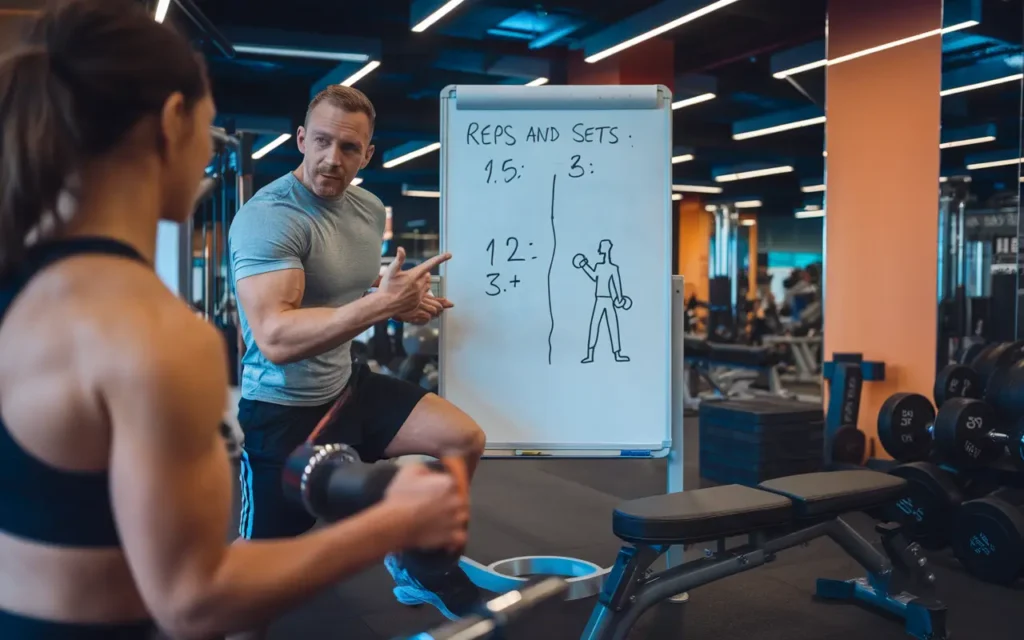Have you ever felt lost in the gym, wondering how many reps or sets you should be doing? Don’t worry; you’re not alone! However, imagine the empowerment of understanding workout reps and sets, the cornerstone of building an effective fitness routine. Whether striving for muscle growth, weight loss, or improved endurance, this knowledge can be a game-changer, putting you in control of your fitness journey. Thus, let’s dive into the world of reps and sets and uncover how they can elevate your fitness journey.
What Are Workout Reps and Sets?

Reps, short for repetitions, refer to the number of times you perform an exercise. For example, if you do ten push-ups in a row, you’ve completed ten reps. In contrast, a set is a group of reps performed consecutively. So, doing ten push-ups three times, with rest in between, equals three sets.
This structure forms the basis for workout routines, helping you measure effort, track progress, and achieve fitness goals.
Why Are Workout Reps and Sets Important?
Reps and sets aren’t just numbers; they’re critical tools for:
Muscle Building
Different training approaches can yield distinct benefits when it comes to muscle building. For instance, high-repetition, low-weight workouts are designed to enhance muscular endurance. These routines typically involve performing more than 12 repetitions per set with lighter weights, allowing your muscles to sustain prolonged activity without fatigue. Consequently, this training style is ideal for athletes looking to improve performance in endurance sports or for individuals aiming to tone their muscles.
Conversely, low-repetition, high-weight workouts focus on increasing overall strength. In these routines, individuals typically perform fewer than 6 to 8 repetitions per set using significantly heavier weights. This method places more stress on the muscles, leading to greater muscle fiber recruitment and adaptations that increase strength and power. Therefore, this type of training is particularly beneficial for those looking to build muscle mass or optimize their performance in strength-based activities.
Moreover, incorporating both strategies into a balanced workout regimen can help individuals achieve a well-rounded fitness level, catering to endurance and strength goals.
Fat Loss
Incorporating structured sets into your workout routine can significantly enhance your overall fat-loss efforts. Specifically, organizing your exercises into specific sets and repetitions keeps your heart rate elevated throughout the session. This sustained elevation in heart rate maximizes your calorie burn during the workout. It promotes an afterburn effect, where your body continues to burn calories even after exercising. Additionally, structured sets can help improve your mental focus and ensure you work optimally, further contributing to your fat loss goals.
Efficiency
Focusing on reps and sets targets specific muscle groups, ensuring effective engagement during workouts. By defining the number of reps and sets, you can tailor your training to improve muscle strength, endurance, or hypertrophy based on your fitness goals. This structured approach allows you to systematically target each muscle group, providing adequate stimulus for growth and adaptation. Properly planning your reps and sets can improve performance, reduce the risk of injury, and use your workout time more efficiently. By comprehending and using these principles, you can optimize your training sessions and achieve your fitness objectives more effectively.
Understanding the Relationship Between Reps and Sets
The relationship between reps and sets determines the outcome of your workout:
Strength Training
Involves performing fewer repetitions, typically ranging from 3 to 6, while using heavier weights to stimulate muscle growth and strength gain. This approach generally includes executing multiple sets of each exercise, often ranging from 3 to 5 sets. The heavyweights challenge your muscles, leading to increased strength, hypertrophy, and improved performance in various physical activities. Focusing on proper form and technique when using heavier loads is essential to prevent injury and ensure effective training outcomes. Additionally, adequate rest between sets is crucial to allow for recovery and maintain optimal lifting performance throughout the workout.
Hypertrophy
To achieve muscle hypertrophy, focus on performing moderate repetitions, generally 8 to 12 reps per set. This range is optimal for stimulating muscle growth. Utilize a moderate weight that allows you to maintain proper form throughout the entire set while still providing a challenging resistance. Choosing a weight that leads to muscle fatigue by the end of your set is crucial for stimulating muscle growth. Integrate varied exercises targeting different muscle groups, and consider resting for 30 to 90 seconds between sets to maximize your results.
Endurance
Endurance training uses lighter weights to perform higher repetitions, typically between 12 and 20. This approach helps to improve muscular endurance, which is essential for sustained physical activity over extended periods. Utilizing lighter weights decreases the risk of injury while allowing for a greater volume of work. Engaging in this training helps enhance your overall stamina, builds more efficient energy systems in your muscles, and improves your ability to perform tasks for longer durations without fatigue.
How to Choose the Right Number of Reps and Sets

Selecting the appropriate number of repetitions (reps) and sets is crucial for optimizing your training routine, and it often depends on your fitness level and specific goals. Here’s a more detailed breakdown:
Beginners
If you are new to strength training, aim to perform 2-3 sets of 8-12 reps. This range is ideal for building a solid foundation of strength and familiarizing yourself with various exercises. Mastering your form and technique is essential during this stage to prevent injury and promote long-term progress.
Intermediates
Once you have gained some experience, you can transition to doing 3-4 sets with a rep range that suits your specific objectives—building muscle, increasing endurance, or improving overall strength. For example, if your goal is hypertrophy (muscle growth), you might stick to 8-12 reps. However, if you’re looking to build endurance, you could increase the number of reps to somewhere around 12-15. Consider varying your routines every few weeks to keep challenging your muscles and to avoid plateaus.
Advanced
For those with significant weight training experience, consider doing 4-6 sets per exercise, incorporating a variety of rep ranges to keep your muscles guessing and push your limits. For instance, you could mix lower rep ranges (3-6 reps) for strength building with higher rep ranges (8-15 reps) for hypertrophy. Integrating advanced techniques such as supersets, drop sets, or rest-pause sets can also enhance the intensity of your workouts.
When planning your workout routine, consider your fitness level, specific goals, and your body’s recovery capacity. Pay attention to your body and modify your sets and reps to prevent overtraining and allow sufficient recovery time. This careful consideration will help you achieve optimal results in your fitness journey.
Common Types of Reps and Sets in Workouts
Understanding the different types of repetitions (reps) and sets is crucial when designing effective workout programs. Here are some common structures:
Straight Sets
This approach entails performing the same number of repetitions for each set of an exercise. For example, if you do three sets of bench presses, you might perform 10 reps in each set. This simple method promotes consistent strength gains by allowing you to focus on maintaining or increasing the weight used.
Supersets
Supersets involve pairing two exercises that target either the same or opposing muscle groups, executed back-to-back with minimal rest in between. For example, you could perform a set of bicep curls followed by a set of triceps extensions. This technique can enhance workout efficiency and increase the intensity, providing a greater metabolic demand on the body.
Drop Sets
You begin with a heavier weight in a drop set and perform as many reps as possible until failure or near failure. After reaching that point, you immediately decrease the weight and perform additional reps without resting. For example, if you start with 20 pounds and perform 10 reps, you might drop to 15 pounds and do another set until failure. This method effectively pushes muscles beyond normal fatigue, promoting muscle growth and endurance.
Pyramid Sets
Pyramid sets are structured as either ascending or descending. In an ascending pyramid, you start with a lighter weight and increase the weight while decreasing the number of reps in each subsequent set (e.g., 12 reps at 10 lbs, 10 reps at 15 lbs, 8 reps at 20 lbs). In contrast, a descending pyramid involves starting with a heavier weight and decreasing the weight while increasing the number of reps as you go. This approach can effectively enhance both strength and endurance over time.
AMRAP (As Many Reps As Possible)
An AMRAP set focuses on pushing your limits by performing as many repetitions of a particular exercise as possible within a specified time frame, typically 5 to 15 minutes. For instance, doing as many push-ups as possible in 10 minutes encourages muscular endurance and effective conditioning, as it challenges your body to sustain output over time.
Each type of rep and set variation adds distinct benefits and variety to workout routines, allowing training to be tailored to specific fitness objectives, such as increasing strength, building muscle, or improving endurance.
Common Mistakes with Reps and Sets

When people work out, they often make typical errors regarding how many times they repeat an exercise and how many groups of those repetitions they do. Here are some common mistakes to watch out for:
Overtraining
One of the most significant pitfalls in strength training is overtraining, which occurs when individuals perform excessive sets and reps without adequate recovery time. This can result in physical and mental burnout, manifesting as fatigue, decreased performance, and increased susceptibility to injury. Balancing workout intensity and volume with sufficient rest is crucial to avoid these adverse effects.
Ignoring Rest Periods
Rest periods play a vital role in any training regimen. When individuals neglect to incorporate rest intervals between sets, they risk compromising their recovery and overall performance. Adequate rest allows muscles to recover, replenishes energy stores, and prevents fatigue from accumulating, all of which are essential for optimal strength gains and endurance. Therefore, adhering to structured rest periods tailored to the intensity of the workout can significantly enhance performance and results.
Poor Form
Another common mistake is prioritizing high repetitions or heavier weights over maintaining proper technique. Sacrificing form in favor of quantity poses a higher risk of injury, as incorrect movements can lead to strains, sprains, and other injuries. Focusing on executing each repetition with proper form not only promotes safer workouts but also ensures that the intended muscle groups are effectively targeted, leading to better strength development and performance in the long run. Maintaining a strong foundation in technique should always come first, regardless of the number of reps or sets performed.
Tips for Optimizing Your Reps and Sets
Progressive Overload
Implementing progressive overload in your workout is vital to building strength and muscle. This concept involves progressively increasing the weight you lift or the repetitions you perform over time. Start by assessing your current capabilities, and then aim to add small increments of weight—typically around 5%—every week or two. Alternatively, you can increase your reps within the same weight range until you feel ready to up the weight. This method not only challenges your muscles but also encourages growth and adaptation.
Incorporate Rest
Rest is essential for letting your muscles recuperate and grow stronger. Depending on your training goals—strength, hypertrophy, or endurance—the recommended rest intervals between sets can vary. Take 30-60 seconds of rest for hypertrophy training (to build muscle size) and 60-90 seconds for strength training (to lift heavier weights). Pay attention to how your body feels during workouts; finding the right balance of rest can help maximize your performance in subsequent sets.
Track Progress
Monitoring your progress is key to understanding your growth and adjusting your routine. Consider using a workout journal or a fitness tracking app to log your exercises, weights, and repetitions each session. This keeps you accountable and allows you to look back and see how far you’ve come, offering insights into what works best for your body and where you might need to change your strategy.
Stay Consistent
While it’s essential to stick to a well-structured workout plan, be open to making adjustments based on your body’s responses. Consistency is crucial for long-term success, but avoid the trap of monotony by periodically varying your exercises, the order in which you perform them, or the intensity of your workouts. This adaptability keeps your routine fresh and helps prevent plateaus, allowing you to continue progressing toward your fitness goals. Regular reevaluation of your plans will ensure you remain aligned with your objectives while keeping your workouts enjoyable.
FAQS
Beginners should start with 2 to 3 sets of 12 to 15 reps using light to moderate weights. Focus on learning proper form before increasing intensity.
The ratio depends on your goal. For strength, rest for 2–3 minutes after each set. For endurance, aim for 30–60 seconds between sets.
No, different exercises target different muscle groups and require varied rep ranges. Compound movements usually have lower reps with heavier weights, while isolation exercises may use higher reps.
Yes, periodically adjusting your routine helps prevent plateaus and keeps workouts challenging. Incorporate different rep ranges and exercise variations every few months.
Yes, exercises like push-ups, pull-ups, and squats can build muscle. Adjust reps and sets to include progressive overload by increasing difficulty or volume.
Conclusion
Mastering workout reps and sets is crucial to reaching your fitness goals. By understanding their role, avoiding common mistakes, and optimizing your routine, you can unlock new levels of strength, endurance, and overall performance.
Progression is key, and listening to your body ensures sustainable success. Combine proper reps and sets with rest, variety, and consistency for a fitness journey that delivers long-term results.
Ready to take the next step? Plan your workout today, focusing on reps and sets, and experience the difference!

